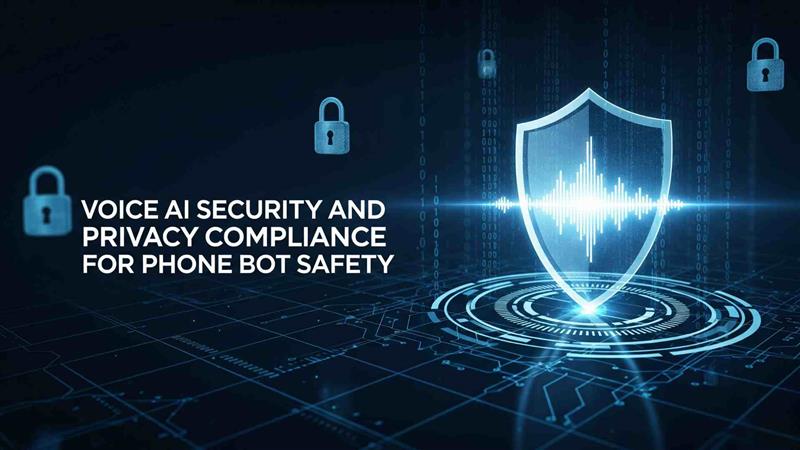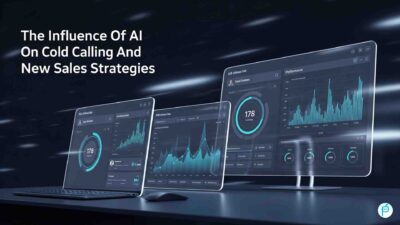TL;DR Voice AI technology has transformed customer service interactions across industries worldwide. Businesses deploy intelligent phone bots to handle thousands of customer calls daily. These systems process sensitive personal information during every conversation.
Table of Contents
Data security concerns have grown alongside voice AI adoption rates. Customers share credit card numbers, social security details, and private health information. Companies face strict regulatory requirements for protecting this sensitive data.
Voice AI security and privacy compliance has become essential for business operations. Proper implementation protects customer trust and prevents costly data breaches. Smart security measures ensure regulatory compliance while maintaining system functionality.
Understanding Voice AI Security and Privacy Compliance
Voice AI security and privacy compliance encompasses comprehensive data protection measures for automated phone systems. These protocols safeguard customer information throughout the entire conversation lifecycle. Security frameworks protect data during collection, processing, storage, and transmission phases.
Compliance requirements vary by industry and geographic location significantly. Healthcare organizations must follow HIPAA regulations for patient information protection. Financial institutions adhere to strict PCI DSS standards for payment data security.
Privacy regulations like GDPR and CCPA impose additional requirements on customer data handling. Companies must obtain explicit consent before collecting personal information. Data retention policies specify how long information can be stored legally.
Voice AI systems require specialized security measures due to audio data complexity. Speech patterns contain unique biometric identifiers requiring enhanced protection. Real-time processing demands secure data transmission protocols.
Core Security Principles for Voice AI Systems
Data Encryption Standards
Encryption forms the foundation of secure voice AI implementations. Advanced encryption protocols protect data during transmission between systems. AES-256 encryption standards ensure maximum security for stored audio files.
End-to-end encryption prevents unauthorized access during data transfer. Encrypted connections secure communication between phone systems and AI platforms. SSL/TLS certificates validate system authenticity and prevent man-in-the-middle attacks.
Database encryption protects stored customer information from unauthorized access. Field-level encryption secures specific data elements like payment information. Key management systems control access to encryption keys securely.
Voice data requires specialized encryption due to its unique characteristics. Audio compression algorithms must maintain encryption integrity. Real-time encryption enables secure live conversation processing.
Access Control and Authentication
Multi-factor authentication prevents unauthorized system access effectively. Role-based access controls limit user permissions to necessary functions only. Regular access reviews ensure appropriate permission levels are maintained.
User authentication protocols verify identity before granting system access. Strong password requirements enforce secure credential management. Automated logout features prevent unauthorized access to idle sessions.
API authentication secures connections between voice AI systems and external applications. Token-based authentication enables secure third-party integrations. Rate limiting prevents brute force attacks on system endpoints.
Administrative access requires enhanced security measures and monitoring. Privileged access management systems control high-level system permissions. Audit logs track all administrative actions for security compliance.
Network Security Architecture
Secure network architecture isolates voice AI systems from potential threats. Firewalls block unauthorized traffic and prevent system intrusions. Network segmentation limits the scope of potential security breaches.
Virtual private networks protect data transmission over public internet connections. Dedicated network connections provide enhanced security for high-volume implementations. Network monitoring systems detect suspicious activity and potential threats.
DDoS protection prevents service disruptions from malicious attacks. Load balancing distributes traffic to prevent system overload. Redundant network connections ensure continuous service availability.
Intrusion detection systems monitor network traffic for suspicious patterns. Automated response systems can isolate compromised network segments. Regular penetration testing validates network security effectiveness.
Regulatory Compliance Frameworks
GDPR and Data Protection Requirements
The General Data Protection Regulation imposes strict requirements on European customer data handling. Voice AI systems must obtain explicit consent before processing personal information. Customers have the right to access, modify, or delete their stored data.
Data minimization principles require collecting only necessary information for service delivery. Purpose limitation restricts data use to specified business functions. Storage limitation requires deleting data when no longer needed.
Privacy by design mandates building data protection into system architecture. Data protection impact assessments evaluate potential privacy risks. Data protection officers oversee compliance with GDPR requirements.
Cross-border data transfers require appropriate safeguards and legal frameworks. Standard contractual clauses enable secure international data sharing. Adequacy decisions validate data protection levels in recipient countries.
HIPAA Compliance for Healthcare Applications
Healthcare voice AI systems must comply with Health Insurance Portability and Accountability Act requirements. Protected health information requires enhanced security measures and access controls. Business associate agreements govern third-party data processing relationships.
Physical safeguards protect computing systems and equipment containing health information. Administrative safeguards ensure proper workforce training and access management. Technical safeguards control access to electronic health information systems.
Audit controls monitor access to health information and detect unauthorized activities. Data integrity measures protect health information from improper alteration or destruction. Transmission security protects health information during electronic transmission.
Breach notification requirements mandate reporting security incidents within specific timeframes. Risk assessments evaluate potential threats to health information security. Incident response procedures ensure proper breach investigation and resolution.
PCI DSS Standards for Payment Processing
Payment Card Industry Data Security Standards govern systems processing credit card information. Voice AI systems handling payment data must maintain secure processing environments. Regular security assessments validate ongoing compliance with PCI requirements.
Cardholder data encryption protects sensitive payment information during processing and storage. Secure transmission protocols prevent interception of payment data. Access controls limit cardholder data access to authorized personnel only.
Network security measures protect systems storing or processing cardholder data. Regular security testing validates the effectiveness of protective measures. Security policies and procedures ensure consistent compliance implementation.
Vulnerability management programs identify and address security weaknesses proactively. Change management procedures ensure security considerations in system modifications. Incident response plans address potential security breaches effectively.
Technical Implementation Strategies
Secure Data Processing Pipelines
Voice AI security and privacy compliance requires secure data processing architectures. Audio data flows through encrypted pipelines from collection to analysis. Secure processing environments prevent unauthorized data access during analysis.
Data anonymization techniques remove personally identifiable information from audio recordings. Voice biometric data requires specialized anonymization approaches. Tokenization replaces sensitive data with non-sensitive placeholder values.
Real-time processing capabilities enable immediate data analysis without long-term storage. Stream processing architectures minimize data retention periods. Edge computing reduces data transmission requirements and security risks.
Quality assurance processes validate data protection measures throughout processing pipelines. Automated testing ensures security controls function properly. Continuous monitoring detects potential security vulnerabilities or breaches.
Privacy-Preserving AI Techniques
Differential privacy adds mathematical noise to protect individual data privacy. Federated learning enables AI training without centralizing sensitive data. Homomorphic encryption allows computation on encrypted data without decryption.
Synthetic data generation creates realistic training data without using actual customer information. Privacy-preserving machine learning techniques protect training data confidentiality. Secure multi-party computation enables collaborative AI development without data sharing.
Data masking techniques hide sensitive information during system testing and development. Pseudonymization replaces identifying information with artificial identifiers. Data synthesis creates statistically similar datasets without actual personal information.
Privacy impact assessments evaluate potential risks from AI system deployments. Risk mitigation strategies address identified privacy concerns proactively. Regular privacy audits ensure ongoing compliance with protection requirements.
Monitoring and Audit Systems
Comprehensive logging systems record all voice AI system activities. Security information and event management platforms analyze log data for threats. Real-time monitoring detects suspicious activities and potential security incidents.
Audit trails provide detailed records of data access and processing activities. Tamper-proof logging prevents modification of security records. Automated alerting systems notify administrators of potential security issues.
Performance monitoring ensures security measures do not impact system functionality. User activity monitoring tracks access patterns and identifies anomalies. Compliance monitoring validates adherence to regulatory requirements continuously.
Regular security assessments evaluate the effectiveness of protective measures. Penetration testing simulates attacks to identify vulnerabilities. Vulnerability scanning identifies potential security weaknesses in system components.
Best Practices for Implementation
Security Architecture Design
Secure voice AI architectures implement defense-in-depth strategies. Multiple security layers provide redundant protection against various threats. Zero-trust principles verify every user and device before granting access.
Microservices architectures limit the scope of potential security breaches. Container security measures protect isolated application components. Service mesh technologies provide secure communication between system components.
Cloud security configurations follow industry best practices and vendor recommendations. Infrastructure as code ensures consistent security configurations across deployments. Automated security scanning validates configuration security continuously.
Disaster recovery planning ensures business continuity during security incidents. Backup systems protect against data loss from security breaches. Recovery procedures minimize downtime and service disruption.
Staff Training and Awareness
Security awareness training educates employees about voice AI security requirements. Regular training updates cover emerging threats and protection techniques. Role-specific training addresses unique security responsibilities for different positions.
Incident response training prepares staff for security breach scenarios. Tabletop exercises simulate security incidents and test response procedures. Communication protocols ensure proper notification during security events.
Privacy training covers regulatory requirements and company policies. Data handling procedures specify appropriate methods for managing customer information. Regular assessments validate staff understanding of security requirements.
Vendor management training addresses third-party security risks and requirements. Due diligence procedures evaluate vendor security capabilities. Contract negotiations include appropriate security and privacy provisions.
Continuous Improvement Processes
Regular security assessments identify areas for improvement in voice AI systems. Gap analyses compare current security measures against industry standards. Risk assessments evaluate potential threats and vulnerabilities.
Security metrics track the effectiveness of protective measures over time. Key performance indicators measure security program success. Regular reporting provides visibility into security posture and trends.
Threat intelligence integration provides information about emerging security risks. Security research keeps organizations informed about new attack techniques. Industry collaboration shares threat information and best practices.
Technology updates ensure voice AI systems include latest security enhancements. Patch management procedures address security vulnerabilities promptly. Security testing validates updates before production deployment.
Future Security Considerations
Emerging Threat Landscapes
Artificial intelligence attacks target voice AI systems with sophisticated techniques. Adversarial examples attempt to fool AI models with malicious inputs. Model poisoning attacks corrupt AI training data to compromise system behavior.
Deepfake technology creates realistic but fraudulent voice recordings. Voice cloning attacks impersonate legitimate users to gain unauthorized access. Biometric spoofing attempts bypass voice authentication systems.
IoT device integration expands attack surfaces for voice AI systems. Edge computing introduces new security challenges and requirements. 5G networks provide new capabilities but also create additional security considerations.
Quantum computing threatens current encryption standards and security measures. Post-quantum cryptography development addresses future security requirements. Migration planning ensures smooth transitions to quantum-resistant security measures.
Regulatory Evolution
Privacy regulations continue evolving to address new technologies and risks. Voice AI systems must adapt to changing regulatory requirements. International cooperation improves cross-border data protection frameworks.
Industry-specific regulations address unique voice AI security requirements. Sector-specific standards provide detailed implementation guidance. Certification programs validate compliance with security standards.
Automated compliance tools simplify regulatory adherence for voice AI systems. Regulatory technology solutions streamline compliance reporting and monitoring. AI-powered compliance systems detect potential violations automatically.
Read More: Ensure Compliance With Voice Bot For Debt Collection
Conclusion

Voice AI security and privacy compliance represent a critical foundation for successful automation implementations. Proper security measures protect customer trust and prevent costly data breaches. Comprehensive compliance frameworks ensure adherence to regulatory requirements.
Organizations must invest in robust security architectures and ongoing monitoring systems. Staff training and awareness programs ensure consistent security implementation. Continuous improvement processes adapt to evolving threats and requirements.
The future of voice AI depends on maintaining customer confidence through strong security practices. Privacy-preserving technologies enable innovation while protecting sensitive information. Strategic security investments create competitive advantages and customer loyalty. Successful voice AI deployments balance functionality with comprehensive data protection measures. Security and privacy considerations must be integrated throughout system design and implementation. Proactive security approaches prevent issues rather than simply responding to them.






[…] laws inadequately address AI safety risks comprehensively. Legal systems lag behind technological advancements significantly. International […]
[…] Read More: Voice AI Security And Privacy Compliance For Phone Bot Safety […]
[…] automated calling systems must navigate complex regulations across multiple jurisdictions. Voice bot legal requirements vary significantly between countries, states, and […]
[…] regulations affect voice AI implementation. Healthcare organizations must comply with HIPAA. Financial services face additional regulatory […]
[…] Failover Protocols: Secondary systems activate automatically during primary failures. Voice AI reliability remains uninterrupted during transitions. Customers never experience service […]